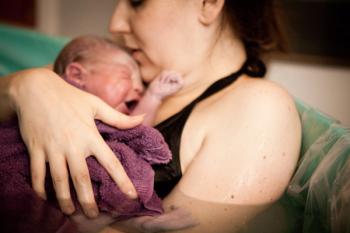
Oocyte Donation using Cryopreserved Donor Oocytes
58th Annual Meeting - Seattle, Washington - October 2002
Mark Perloe, MD: “I’m Mark Perloe from Georgia Reproductive Specialists, and I’m here at the American Society for Reproductive Medicine with Dr. Dunsong Yang who is the Laboratory Director at the Florida Institute of Reproductive Medicine in Jacksonville, Florida. Thank you for joining us. You had an interesting presentation this morning on Cryopreservation of oocytes. As a reproductive endocrinologist we frequently have patients who come in and say, ‘You know I’m getting older and I’d like to think about freezing my eggs’. Tell us a little bit about your work and how that might bring us closer to making that a possibility.”
Dunsong Yang, MD: “Thank you. What we have done we have actually achieved yes, we can have the similar success rate, I mean the pregnancy implantation rate same as we freeze the oocyte embryos. So oocyte freezing is almost as successful as the embryo freezing.”
Mark Perloe, MD: “So you took a group of patients who were egg donors?”
Dunsong Yang, MD: “In this abstract yes, we use the donor oocyte at and freeze some extra or split first, split cycle. If we don’t have a second recipient we can freeze half of them and use these when the other recipient comes back.”
Mark Perloe, MD: “I see, so that certainly makes oocyte donation more…”
Dunson Yang, MD: “Efficient, yes…”
Mark Perloe, MD: “…cost effective and efficient if you don’t have to…”
Dunsong Yang, MD: “Yes, yes, so we don’t have oocyte waste.”
Mark Perloe, MD: “What was the outcome in the frozen cycle? And was the outcome of the fresh cycle predictive of the people who got pregnant using the frozen eggs?”
Dunsong Yang, MD: “We have not really tried to look into that but it’s certain if you get good quality oocytes then you will get good results after thaw.”
Mark Perloe, MD: “So these were all metaphase two…?”
Dunsong Yang, MD: “Yes.”
Mark Perloe, MD: “…oocytes at the time? Did you require maturation prior to freezing?”
Dunsong Yang, MD: “Yes, we froze almost everything including the immature oocyte but we did not try to mature the oocyte after the thawing. If we found very immature oocyte, we just discarded them. We only used those mature oocyte. But this is about donor oocyte. We also froze, for instance, some patient’s oocyte or for even the young women they want maybe to postpone their childbearing age. So we also do for this, and also for cancer patients.”
Mark Perloe, MD: “The cost of going through a stimulation cycle and a retrieval to freeze a given number of oocytes for subsequent use is still quite high. Is this something that at present you’re clinically offering to people who want to freeze oocytes to go through a cycle and have eggs removed or is it still part of a research protocol?”
Dunsong Yang, MD: “Our work is still under Institution Review Board licence or whatever like that and so it’s still considered as a research protocol.”
Mark Perloe, MD: “Now, in many situations where we get called upon to offer this, it’s women who are faced with imminent treatment for cancer.”
Dunsong Yang, MD: “Yes.”
Mark Perloe, MD: “Either breast cancer or chemotherapy for leukaemia or other types of cancer. Is this the type of procedure they may consider?”
Dunsong Yang, MD: “It’s up to the patient. We certainly give the patient the counselling and if they really want to do it we’d certainly give them this option. Some patients really insist that they want to do this. They think that fertility is more important than anything else.”
Mark Perloe, MD: “Now, the stimulation. Is there anything unique in the stimulation? Are you pushing with higher drugs to get more eggs or would it be a standard stimulation that you would use in any patient undergoing this?”
Dunsong Yang, MD: “Maybe, because I’m not a physician I don’t know what their strategy is; I just do the lab work.”
Mark Perloe, MD: “And is this a protocol similar to freezing embryos? Why have we been able to freeze embryos for many years now but the technology and the capabilities of oocyte freezing has lagged behind?”
Dunsong Yang, MD: “I think that just oocyte is quite different and even the member of the oocyte is different compared to the embryos. The second part, is maybe most important, which is the spindle of the oocyte, and including injury of the spindle is very important.”
Mark Perloe, MD: “There is a technology that I saw on the floor here called “SpindleView”.”
Dunsong Yang, MD: “Yes.”
Mark Perloe, MD: “Is this technology useful or are there other technologies that you see coming out that may help us better evaluate the viability of the oocyte after freezing?”
Dunsong Yang, MD: “This is very interesting. I saw one of the groups from Korea. They actually used that post scope to check the spindle before freezing and after freezing. They showed they actually have the spindle recovering older oocyte.”
Mark Perloe, MD: “So we’re learning a lot more about this and hopefully it will be become more routinely available as the protocols are worked out. Thank you so much for joining us today.”
Dunsong Yang, MD: “All right, thank you.”
Newsletter
Get the latest clinical updates, case studies, and expert commentary in obstetric and gynecologic care. Sign up now to stay informed.











